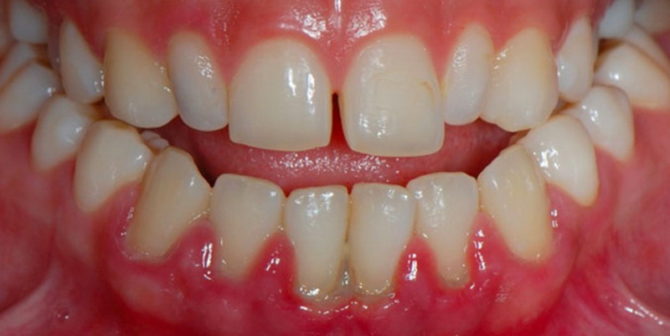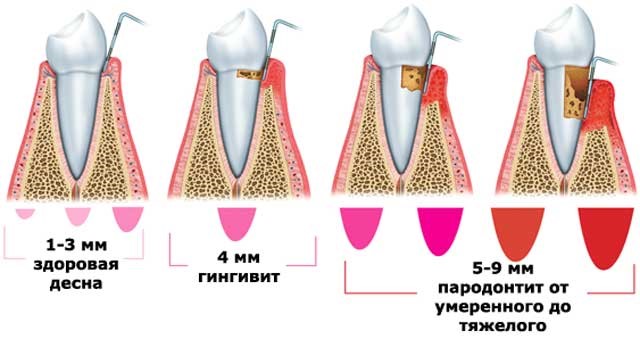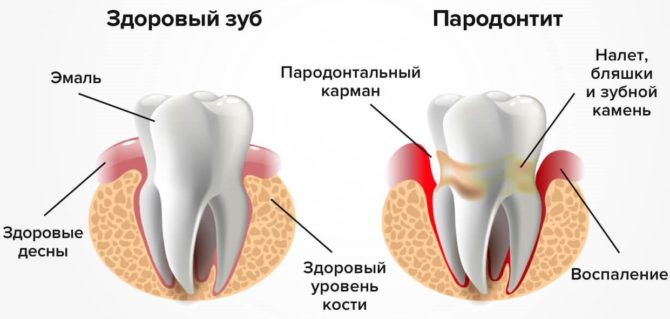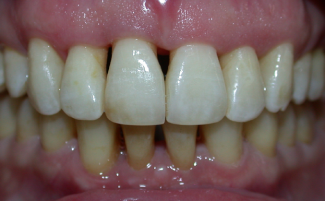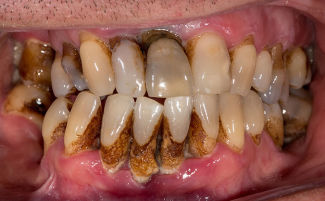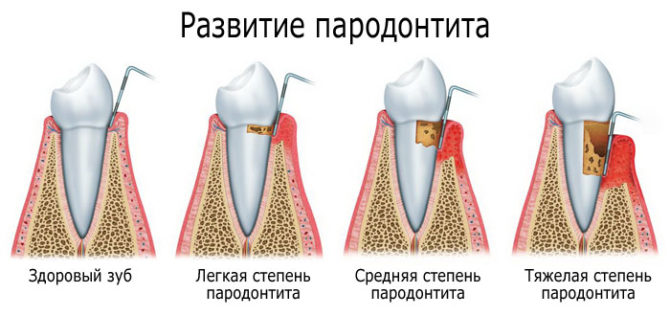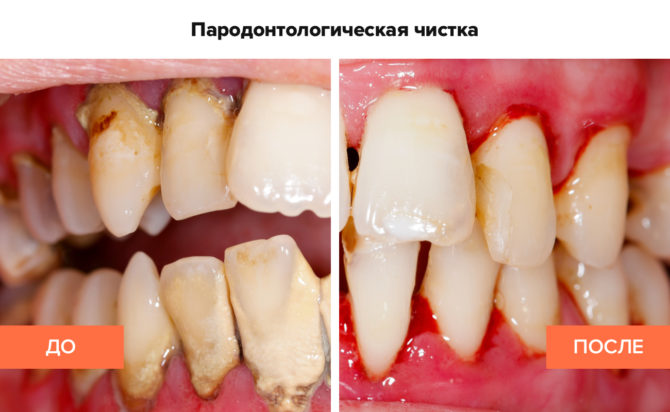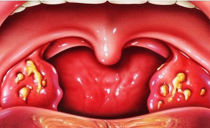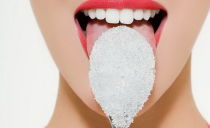Symptoms of periodontitis, conservative and alternative treatment at home
Inflammation of the periodontium - the tissues surrounding the tooth - is observed in people of different ages. Dental disease can occur due to bacterial infection of the mucous membrane of the gums or against the background of internal disorders in the body. The most effective way to treat periodontitis is medication, coupled with folk remedies.
Content
Causes and features of the development of the disease
The strength of the tooth in the alveolus (jaw pocket) depends on the condition of the surrounding tissues or periodontal: gums, periodontal, bone tissue of the alveoli, cement. The inflammatory process, covering these structures, indicates the development of periodontitis.
Infectious damage to the connective tissues surrounding the tooth is a common occurrence observed in 90% of the adult population. According to statistics, only in Moscow periodontal diseases were detected in 20% of children under 12 years of age.
The following factors contribute to the development of the pathological process:
- trauma to soft periodontal tissues during filling of carious cavities and dental canals;
- advanced forms of gingivitis;
- non-compliance with oral hygiene;
- malocclusion, tooth growth;
- deep caries;
- smoking;
- stress
- mechanical damage to the periodontium;
- hypertonicity of muscles during chewing;
- burns of the oral mucosa;
- hormonal disorders;
- diseases of the kidneys, liver, gall bladder;
- diabetes.
The main reason for the development of periodontitis is a bacterial infection, leading to the destruction of the soft and bone tissues that hold the tooth in the alveolus. With a prolonged course, the inflammatory process leads to shakiness and loss of teeth, the development of complications.
Medical treatment of periodontitis at home is effective only with the initial symptoms of inflammation, later splinting of moving teeth or surgical intervention may be required.
Symptoms of periodontitis, photo
With careful attention to the health of the oral cavity and regular visits to the dentist, you can timely notice the first signs of the development of periodontitis:
- putrid breath;
- bleeding gums during brushing;
- weak swaying of dental units;
- increased sensitivity of enamel to hot and cold products;
- the appearance at the bottom of the crown is a soft yellowish plaque.
With early detection of periodontitis, it is possible to treat it at home. If you ignore the signs of the disease, periodontal pockets will continue to increase, which is fraught with the spread of infection deep into the tooth - to its root.
With the further development of pathology, the periodontal painful perception of hot and cold food increases, the deformation of the interdental septa begins, the following symptoms appear:
- accumulation of pus in tooth pockets;
- exposure of roots;
- severe loosening of the teeth and the appearance of gaps between them;
- deformation of the dentition.
With periodontitis of moderate and severe severity, the help of a periodontist is required, which consists in cleaning the periodontal pockets of tartar and pus, splinting of mobile teeth or surgical intervention.
Additional signs of the disease are:
- discomfort when chewing food;
- cyanotic shade of tooth papillae;
- abscesses and fistulas in the oral cavity;
- saliva viscosity;
- decrease in the level of bone tissue of the jaw;
- throbbing in the gums;
- enlarged submandibular lymph nodes;
- headaches.
Severe periodontitis is fraught with tooth loss and the development of periodontal disease - a pathology accompanied by atrophy of the alveolar process of the jaw. This disease is not attributed to inflammatory manifestations, but to systemic periodontal disease.
Classification of periodontitis
There are several stages of the development of periodontal inflammation:
- initial;
- easy;
- average;
- heavy.
Periodontitis can be cured in just a few weeks, if you consult a doctor at the initial or easy stage of its development. Getting rid of the severe stages of the disease takes longer and more difficult. Recession (lowering) of the gums is maintained.
By duration of the course
The duration and nature of the course distinguish the following forms of periodontal disease:
- Sharp. The inflammatory process begins quickly and leads to a sharp deformation of the tissues surrounding the tooth. It is accompanied by pain, the appearance of abscesses, bleeding gums. It is more common in children due to their increased activity, often leading to jaw injuries.
- Chronic There is a gradual and persistent infectious lesion of the periodontium, many times complicating the therapy. Against the background of stresses, weakened immunity, and secondary inflammatory diseases, periods of exacerbation of the pathology begin. Treatment inhibits periodontal destruction during remission, but only temporarily, since getting rid of chronic periodontitis is difficult forever.
By prevalence
According to the prevalence of lesions, two types of periodontitis are distinguished:
- Localized. It covers a small area - periodontal tissues near several teeth. The cause of the development of a localized form of pathology is often injuries.
- Generalized. Extensive inflammation of periodontal tissues around the teeth on one or two jaws. The cause of the disease may be due to trauma or periodontal infection.
Is Periodontitis Cured Forever
Treatment of periodontal inflammation begins with a trip to dentistry and consultation with a periodontist. Based on the examination and symptoms, the doctor:
- determines the condition of the gums and teeth;
- prescribes medicine;
- conducts medical procedures;
- explains how to treat periodontitis at home.
In advanced cases, medications, splinting, surgery are prescribed. With a mild course of pathology, treatment with folk and medication is recommended.
Cleaning the gingival pockets
First of all, with periodontitis, professional dental cleaning of tartar is carried out using ultrasound or a laser. Plaque and deposits in the gingival pockets are a source of bacterial infection that must be discarded. At an early stage of development, a localized focus of infection is treated quickly.
The device "Vector"
"Vector" is an ultrasound equipment equipped with a special head for brushing teeth, removing microorganisms and polishing enamel. The obvious advantages of the device are manifested:
- in high-quality cleaning of periodontal pockets;
- in painlessness;
- non-traumatic for gums, enamel, dentin;
- in the availability of the treatment procedure.
During the procedure, a special mixture of fluorine and calcium is supplied from the device, which is sent to the pocket and destroys the pathogenic microflora in it forever, quickly removing the bacterial focus of infection.
With the help of the “Vector” apparatus, both therapeutic and preventive measures are carried out to eliminate infection in the gingival pockets and prevent the development of periodontal diseases.
Medicines
Gum periodontitis can be treated with pills and injections. Adults are most often prescribed antibiotics:
- Syphlox.
- Metronidazole.
- Clindamycin.
- Tavirid.
In severe cases of pathology and the presence of concomitant diseases, the use of drugs in the form of injections for intramuscular administration is indicated, since they differ in speed of action and accuracy of dosage. For home treatment, pills are prescribed.
The following procedures have an effective effect in the treatment of periodontal inflammation:
- rinsing the mouth with antiseptics;
- washing of gingival pockets with hydrogen peroxide;
- gel applications for foci of inflammation.
To strengthen the weakened gums, it is necessary to change the toothpaste, for example, to Parodontocid, Lakalut, Paradontax or Forest Balsam.
With periodontitis, local treatment of inflamed gums with ointments, creams or gels is indicated. The action of ointments and creams is restrained by the fatty base. The use of gels, for example, Metrogil Dent, Asept, Holisal, is more effective. The medicinal base of such drugs penetrates the gum tissue faster and destroys bacteria - the main cause of periodontitis.
The duration of the drug course is 10 days. During this period, you need to rinse your mouth with medicinal solutions several times a day, drink healing broths and visit a doctor to treat periodontal infectious diseases with the help of physiotherapy, electrophoresis or laser exposure.
Splinting
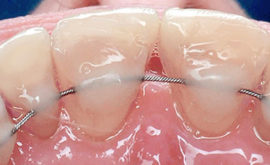 Tooth mobility of the 2nd – 3rd degree serves as the basis for strengthening the dentition by splinting. As a retaining structure, adults install crowns, clasp dentures or a special splinting wire attached to the dental crowns on the inside of the oral cavity.
Tooth mobility of the 2nd – 3rd degree serves as the basis for strengthening the dentition by splinting. As a retaining structure, adults install crowns, clasp dentures or a special splinting wire attached to the dental crowns on the inside of the oral cavity.
The choice of splinting methods depends on the general condition of the oral cavity and the symptoms of the disease. With this procedure, it is possible to strengthen the shaken molars or incisors, fight atrophy of the bone tissue of the jaw, and relieve inflammation.
Surgical treatment of periodontitis
Through surgery, periodontitis is treated only in extreme cases. During the operation, the gingival pockets are cleaned of granulation tissue, and artificial bone chips are planted instead.
Gum massage
Massage is indicated to strengthen the gums. It is carried out independently after each brushing with the thumb and forefinger of one hand. Gums should be taken from two sides of the tooth, making rotational movements from bottom to top for the lower jaw or from top to bottom for the upper.
Massage helps:
- improve the flow of nutrients to the teeth and gums;
- reduce pain;
- relieve inflammation.
Periodontitis treatment at home
It is impossible to cure periodontitis at home only with self-made medicines. Alternative therapy should be combined with conservative. Before treating the pathology at home, you should visit the clinic to remove dental plaque, prescribe medications, the choice of which depends on the cause of the development of periodontitis, and consultations on the possibility of treating the disease with folk remedies.
In addition to drug treatment, you can use decoctions and infusions to rinse your mouth, drink teas with herbs and fruit additives.
The following decoctions, infusions and lotions contribute to disinfection of the oral cavity:
- Comfrey broth.The roots of the plant are crushed, poured with cold water, boiled over low heat, filtered and rinsed with a prepared decoction of the oral cavity twice a day. It is useful to hold it in your mouth for half a minute to enhance the action.
- Infusion of linden and calendula. The flowers of plants are placed in a container and filled with boiling water, insisted in a sealed container for 20 minutes, filtered. Ready infusion rinse your mouth up to 4 times a day. It quickly relieves inflammation. In addition to rinsing the mouth, it is useful to drink tea with the addition of this decoction.
- Decoction of oak bark and linden. Equal parts of oak bark and linden flowers are mixed in crushed form. One spoonful of the mixture is poured with hot water. Insist for an hour, cool. Ready means rinse your mouth after each meal.
- Aloe lotion. The plant helps to get rid of pain instead of pills. A sheet cut in half must be applied to the site of inflammation at night. Treatment is carried out for 6-7 days.
- Vegetable treatment. Some vegetables have a therapeutic antiseptic effect. A significant part of the bacteria dies with the use of sauerkraut. You need to slowly chew its leaves or rinse your mouth daily with cabbage juice. In a week, improvement will come. The disease is treated with sugar beets, used in the form of compresses. The mashed vegetable is applied to the soft tissues near the teeth and can stand for 30 minutes. It helps relieve inflammation.
Prevention of periodontal diseases
Periodontitis is easier to prevent than to cure. Observance of a number of preventive rules will help to avoid the development of this pathology, you need:
- to undergo regular examinations of the oral cavity in the dentistry clinic;
- regularly remove dental plaque;
- observe hygiene - use dental floss, rinse your mouth and brush your teeth several times a day.
In addition, you should diversify the diet, abandon bad habits and begin to lead an active, healthy lifestyle. Treatment of gums affected by periodontitis can last for years, so do not start this disease.

